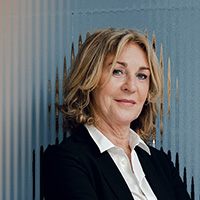
Fabian Schroeder
VP Global Digital – Governance
BSH Home Appliances Group

Fabian Schroeder, VP Global Digital – Governance of BSH Home Appliances Group, previously shared with the CIO community the rational and first steps towards a digital transformation at BSH. Now, Fabian continues the story, sharing some of the successes, key lessons learned, and how adopting methodologies has played a huge part.
How successful has your transformation journey been so far?
As a reminder from the first article, the three key steps in this transformation were:
- Step 1: Treat IT as “part of the business”: IT is business
- Step 2: Change the operating model and embrace agile
- Step 3: Become an Agile Enterprise
We have completed steps one and two. Step one has already resulted in tangible results for the business. For step two, we went live in June 2021 and are about to stabilise (inspect and adapt) the operating model. We can also demonstrate some clear positive results, such as a clear measurement and transparency of our performance in delivering EPICS in the last product increment (PI) cycle.
The company was evolving with its new operating model, but Agile is not something that you can order or command from the top – it’s rather something that has to grow and evolve in a decentralised way, and then we have to bring the things together.
At the centre of our discussions and thinking was always the consumer – how can we ensure the best outcomes? This informed all our decision making from the start.
We needed accountability for the associated outcomes that are delivered to the customer. We also needed an organisational and operating model that gave our people room for development and transparency on what skills we have available.
Our people now have the opportunity to exchange, learn and grow in global functional “people development” areas. At the same time, they deliver customer value in cross-functional agile teams that are directly aligned with the business. Of course, this also required transformation on the business side to be ready for this direct, continuous collaboration. In the end, we are talking about a corporate transformation.
What were the challenges?
Key challenges were ever-changing consumer needs that required fast reaction, the internal digitalisation required, adopting completely new business models, and of course, the rapid development of technology at BSH, especially at the consumer level.
Our responses to these challenges were an agile mindset (culture) and agile methods. With this, the mindset of every single person is evolving. We strive towards consumer orientation in anything we think or do. We are proactively taking accountability to achieve best results based on proactive collaboration across functions. And in this collaboration, we continuously inspect and adapt with feedback as the key capability – no fear of failure, but opportunity to learn! It gives IT the opportunity to team with the business and say we are improving every quarter/PI.
The impact on the culture of adopting a 100% agile way of working was also high.
We are continuously working on improving ‘our agile way of working,’ which means quick results and feedback on prototypes. While this way of working is highly iterative and fast paced, it also requires consequent synchronisation of all rituals. And this synchronisation is not limited to Digital Services, but spans over all business operations up to business strategy and planning.
With this evolving mindset and changed way of working, we have really laid the foundation for us to achieve our targets of being more customer oriented, quicker and better. This will also hopefully mean lower costs with better developed people. It’s also enabled new career models. In fact, we have defined about 30 different roles with circles of influence for each of these roles.
We have to really foster the pull for agile methods by the responsible units, not simply push this onto them. It's a company exercise. It's not a digital diet exercise in the end.
We have now fully introduced Agile, and the business is connecting with us for coaching and adopting agile methods and setup.
What advice would you give to the IT Leaders in your organisation when they are looking to leverage influence at the Board Level? What is their role in digital transformation?
It's really important to think big – not long! – from the beginning, and not just within your given “IT frame” of enterprise applications and infrastructure. If you think about how you can solve challenges within your given system, it will be tough.
You need to think bigger – and with digital at the heart.
Think company-wide and start with the outcomes. Always have the customer in mind and how you can make your service more effective. Start by considering the corporate business model and the IT operating model, not just the “IT organisation.” The organisation is a component that quite naturally comes out at the end.
Build a cross functional team to develop these concepts. Avoid this becoming a ‘top down’ initiative. This is such a big change that you need a large group of people believing in it. If people believe, if they have the opportunity to help create something, you have a much better chance of success.
The key takeaway is to create tangible outcomes fast. You will encounter resistance, but don’t let this slow you down. Make small steps with wins on every step. Clearly point out what the value is for the people involved and what they will gain from this change. The whole model can never be perfect because the environment and demands are ever changing. But that’s why it must be perfectly adaptable, so focus on adaptability.
Over-communicate and over-train, but focus on implementation to substitute communication. Good implementation is better than great theory. Implementation is more powerful, because it is real, not just words. This means you also need courage for “just good enough” and establishing a failure culture with Inspect and Adapt as an ongoing ceremony.
Early positioning is key. Psychology tells us that people don’t take well to negative messaging. If you make it clear that this is an initiative that will only work when business and IT are working in unison, you have a higher chance of success.
To summarise:
- Do not try to solve new problems with old operating models, structures or tools: Develop new agile setup (think big, but not long), starting with the customer
- Fast implementation before great theory – perfection in adaptability with continuous inspect and adapt
- Form an alliance for the change: Involve the (so called) business EARLY; you will fail to solve the topic on your own (within “IT”)
- Plan “smaller” steps with wins on every step; accept realities that take time to change, e.g. “cultural challenge”; be aware that the “business” is not ready for this
The magic is in collaboration, rather than defending key messaging and strategy.
Special thanks to Fabian Schroeder and BSH Home Appliances Group.
Fabian Schroeder is a member of the DACH CIO Community. This is a peer-led community, where other CIOs from top organisations, such as Robert Bosch GmbH, Linde Plc, Andritz, Lufthansa Cargo AG, Aldi Nord, and more, connect virtually and in person to network and learn with each other.
By CIOs, For CIOs®
Join the conversation with peers in your local CIO community.





